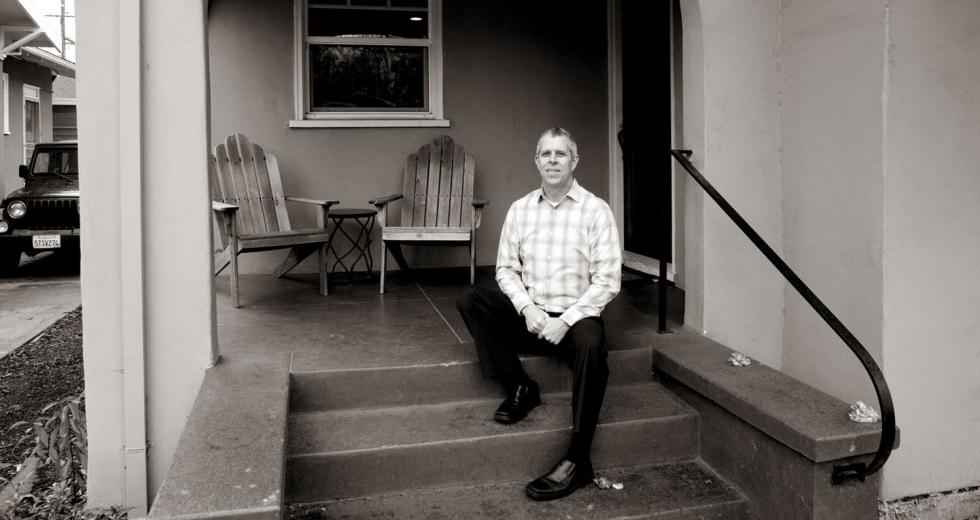Brian O’Hearn is an accidental landlord.
Like more and more homeowners caught in the descending mortgage spiral, O’Hearn and his wife, Juliet Williams, faced tough choices. Married in June, they owned his house in Folsom and her Sacramento condo — and both wanted to live in midtown.
Their solution? Find reliable renters for both homes and rent a restored 1920s bungalow in the thriving midtown area.
O’Hearn, an information technology manager in Folsom, bought his three-bedroom, two-and-a-half bath Folsom home in 2002 for $262,000. Divorced, with shared custody of his son, then 9, he watched his home’s value rapidly increase.
“I basically did a complete remodel,” hiring a designer and subcontractors for some work and doing much of it himself, he says. He refinanced the following year at a lower interest rate, paying off a second mortgage. In 2004, at the height of the bubble, his house was worth nearly double its purchase price.
“I thought I should just sell,” O’Hearn recalls, “but I talked myself out of it because my son was still in school.”
Fast forward to 2010: O’Hearn, 46, and Williams, 39 and a journalist, were living in his Folsom home, and she was renting out her $190,000 Sierra Oaks condo, which she purchased in 2007. O’Hearn had the easy commute, since he worked in Folsom, but Williams hated the daily, traffic-clogged drive to her office near the Capitol.
Something had to give, so they moved to midtown.
“There is a little bit of added expense,” O’Hearn says, “but we’re loving the life.”
Their 1,200-square-foot, three-bedroom, two-bathroom bungalow is close to restaurants, shopping, nightlife and a short distance from Williams’ office. O’Hearn has the longer commute, from midtown to Folsom, but generally without the traffic crunch.
Myriad reasons — marriage, divorce, job changes, financial pressure, unemployment, illness — are behind the increase in “accidental” landlords who opt to rent out their homes rather than sell in a chronically depressed and unpredictable market. Some turn to property managers to handle the details.
Others, such as O’Hearn, handle the often-complex demands of property management, including advertising, screening renters, maintenance, emergency repairs, disputes with neighbors and other issues.
“I’m pretty handy,” says O’Hearn, “and we’ve saved money for unexpected emergencies. Since we wanted to move, this was really the only way we could do it, given the market.”
With no previous experience as landlords, they were careful to thoroughly research — and hopefully avoid — its many variables and pitfalls. Williams checked the requirements of rentals and leases. They advertised on Craigslist for renters, who were required to complete an application and submit references from former landlords and credit reports.
“We’ve been lucky to have good, stable renters,” says O’Hearn, emphasizing the importance of finding responsible tenants, both for the care of the home and the comfort of neighbors.
Like many homeowners, O’Hearn watched helplessly as the value of his house in Folsom tumbled, finally appearing to stabilize around the 2002 purchase price. He was also able to refinance in August to a 20-year loan with a lower interest rate. The current mortgage is $2,000 a month, with taxes and insurance, and is nearly offset by the $1,995 rent. Not so with the condo, which rents for just $1,100 — $300 a month less than it costs — and is nearly $50,000 underwater.
Ideally, O’Hearn says, he and Williams “would rather own the house we’re living in. But under the circumstances, it worked out in order to do what we wanted to do.” At the same time, he says, “I can understand why there are a lot of people now who just want to get out from under the burden” of owning a home that has substantially lost value, and often is worth far less than what is owed.
“It’s not underwater until I sell it,” he says. “We have very, very good credit. If there is a rebound and we have successfully rented both of these places, we still have skin in the game, as opposed to walking away.”
•••
Randy Burden, 62, has bought, remodeled and sold Capital Region homes for more than three decades. The son of a builder, he grew up in Sacramento, graduated from Sacramento State and is skilled in construction, interior design and landscaping. He and his partner, Larry Barnes, 54, enjoy working on distressed properties — all intended as primary residences, not rentals — and making them shine.
Early in their 17-year relationship, they built a house on rural property Barnes owned near Placerville but found the long commute on a narrow two-lane road too treacherous for comfort. So they moved to Gold River, where they bought, renovated and sold several homes, almost always profitably.
Occasionally they have temporarily become landlords as well. In 1995, Burden rented out his first home, purchased in the 1980s in Sacramento’s Pocket area. He accurately predicted the value would continue to appreciate, and he sold it several years later. More recently, he and Barnes became accidental landlords, stuck with substantial mortgages on two homes when one failed to sell.
“We could handle five or six months (with two mortgages),” says Burden, a technology manager at the state Department of Motor Vehicles. “But if it extended into seven, eight or nine months, no. We had already lost so much.”
They purchased their “dream home” in 2005 for $519,000. It was a foreclosure in poor condition, on the market for 18 months. “People would walk in and walk right back out,” Burden says. Just the kind of challenge Burden and Barnes relished. “We thought, ‘What a cool house; we could make this beautiful.’ We completely renovated it back to its beautiful bones. None of these homes were ever [purchased and renovated] with the intention of leaving them. It just turned out that way.”
As they began planning for Burden’s retirement, however, they took stock of the sharply dropping real estate market and decided to sell. “We had put a lot of money into it” — $280,000 on top of the purchase price — “when the market started taking a southward turn,” Burden says. “It became clear we would get less and less the longer we waited.”
They bought a foreclosed, four-bedroom home in May in a gated Gold River community with a clubhouse, tennis courts, pool and spa and put the dream home on the market. Several months passed without a sale, so they lowered the price. Finally, they decided it was time for a short-term lessee.
“I had been a landlord before, with my house in the Pocket, and it worked out well,” Burden recalls.
They considered using professional rental agencies but decided, “We’re savvy enough to do this.” They listed online with a Gold River website and on Craigslist, looking for well-qualified renters. They did reference and credit checks and made it clear to prospective tenants that the lease would be short-term, as they planned to move in once their other house sold, which it did in December for $545,000.
In March their renter’s lease will be up, and they will finally be able to move into their new home, where they have already made major improvements.
“We were very fortunate to have made profits on all of our homes,” he added, “except the last one, which was very painful.”
•••
Michael and Melanie Vance, both 66, are experienced Sacramento homeowners and residential real estate investors who have been buying, renting and selling properties in the Sacramento area since 1976. Both retired high school teachers and principals, they made substantial profits on two family homes they bought and sold, including their first home in Carmichael, which they bought in 1974 for $36,000, selling it for $108,000 six years later.
They used the profit to buy a two-story brick home in the emerging, upscale American River Canyon neighborhood of north Folsom, where they lived for 25 years. They sold the Folsom house for more than $700,000 just before the real estate market crashed, and they bought their current home in Gold River.
All the while, they were also buying “starter-level houses and duplexes” in the Sacramento area as investments for their eventual retirement. Their worst experience involved a Folsom fourplex, which they sold in the late 1980s. “It was a constant worry, with tenants in and out,” Mike says. “The neighbors were complaining that some tenants were dealing drugs, and one tenant had a husband in prison, many children and many boyfriends.”
They did not repeat the experience, sticking to single-family homes and duplexes in the years before and since. “We’ve been through very slow inflationary times, through the ’80s, but we had enough rent coming in that it was paying the mortgages, paying most of the expenses,” Mike says. “Our aim was that appreciation would be where we made the money, not through rents. That’s not true anymore.”
Currently the owners of eight rental properties, three with partners, the couple manages the properties themselves and have suffered some losses in the real estate meltdown, particularly on rentals purchased “at the top of the market.” They bought a Land Park duplex for $537,000 in 2005 with profits from an Orangevale home they sold the same year for $355,000 — more than twice the purchase price. It’s now worth $100,000. “We got out just in time,” says Vance. They have since refinanced the Land Park duplex, recently appraised at $390,000.
“Melanie and I have worked to keep our rentals at a level where we could feel good about living in them,” added Vance, who is a licensed real estate agent as well as an investor. “Not every [investor or landlord] has that as part of [his or her] business model.” As for the impact of more rentals on neighborhoods as a result of more properties being rented, Vance said, “Lots of rentals in a neighborhood almost always leads to lower desirability for owner/occupants. Investors who are absent or are trying to wring profits out of the houses just don’t maintain their properties as well. Higher-end neighborhoods seem to recover better as far as appearances and desirability because they return to a more normal owner/occupant level as the market recovers. Part of that is also pride of ownership.”
Vance’s advice to inexperienced landlords: “If they’re going to manage it themselves, they need to be close by. I keep home warranties on each unit, which many people won’t do. That allows me to plan ahead.” And, while he does many repairs himself, he keeps a list of reliable contractors and handymen.
Predicting that it will be “10 years before we get out of this mire,” he is nonetheless optimistic. “If we found what we think is a great buy now, we would buy it.”
Recommended For You
Property Management 101
The basics of landlording
Ted White has worked in residential property management in the Sacramento area for more than three decades. He gloried in the boom times and helped homeowners and investors slog through the murky waters of the ongoing real estate meltdown in one of the hardest-hit housing markets in the nation.

Rent the American Dream
Sacramento millennials aren't interested in mortgages
Brian Collins is a 26-year-old director of accounts at Sacramento-based mobile applications marketing firm Appency. He makes what he calls “decent money,” is putting lots of it into a 401(k) and has an eye on his financial future. And, like most people his age, he’s decided that buying a house is not part of the plan.



